Airbnb touts unique solutions for all types of travelers in global animated campaign
Posted in: UncategorizedA trio of three 15-seconds spots were created in-house, with animation by Buck.
A trio of three 15-seconds spots were created in-house, with animation by Buck.
The new channel, which will start Sept. 27, will feature distinct programming and, in an unusual move, live programming from the cable network.
Brace yourself: Pepsi’s 125th birthday is coming. The cola brand and pop culture icon plans to usher in its quasquicentennial in epic fashion, honoring its past and looking toward the future by rewarding loyal fans over 125 days. An updated logo, immersive activations, media takeovers, social content and giveaways will keep fans engaged for the…
Football stars and Keegan-Michael Key dream up outlandish storylines in a series of NFL ads that will air throughout the year.
Subway, the largest restaurant chain in the U.S. by store count, announced it was exploring a sale in February.
Ad Age looks at the biggest trends shaping creator marketing and social media this week, from buzzy brand deals to the evolution of creator-led businesses.
Since 2014, e-cigarettes have been the most used tobacco among U.S. youth, according to the Centers for Disease Control and Prevention (CDC). Public health advocates have rung alarm bells over the rise of vaping among young people, with The Evelyn Lilly Lutz Foundation calling it a “national crisis” and “ticking time bomb.” A new PSA…
“It Takes More” campaign marks a ‘huge strategy shift’ for the sports drink owned by Coca-Cola.
Georgia-Pacific toilet paper brand Quilted Northern has dropped the plastic packaging from some of its products, switching to a recyclable paper wrapping. The change, in response to consumer feedback, aims to cut back on plastic pollution. But while plastic-focused environmental groups are praising the move, others are calling it a distraction from the main impact…
“High-energy” commercials, pop-up diner on tap as new logo rolls out.
Picture the scene. A group of male friends are hanging out playing video games when one of them starts making derogatory comments about women. He remarks that women aren’t good at sports, brandishes a nude photo from his DMs and says a former female classmate was “asking for it.” If you were there, would you…
Bubble, an affordably-positioned skincare brand, was a direct-to-consumer startup that is now in roughly 12,000 stores across CVS, Walmart and Ulta.
Around 24 billion items of clothing are donated to charity every year: the majority of these are shipped to Africa. Most are sold in street markets. An estimated 40 per cent, however, are of such poor quality they have no market value. They are literally “rubbish fashion” and are dumped in landfills or burned, becoming major contributors to the local waste crisis. In Ghana, these garments have a name: obroni wawu, ‘Dead White Men’s Clothes’.
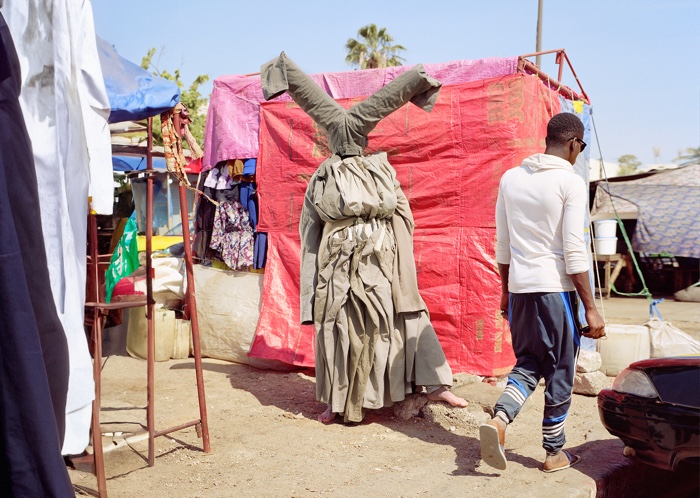
Jeremy Hutchison, Dead White Man, 2022-2023. Photo by Dani Pujalte
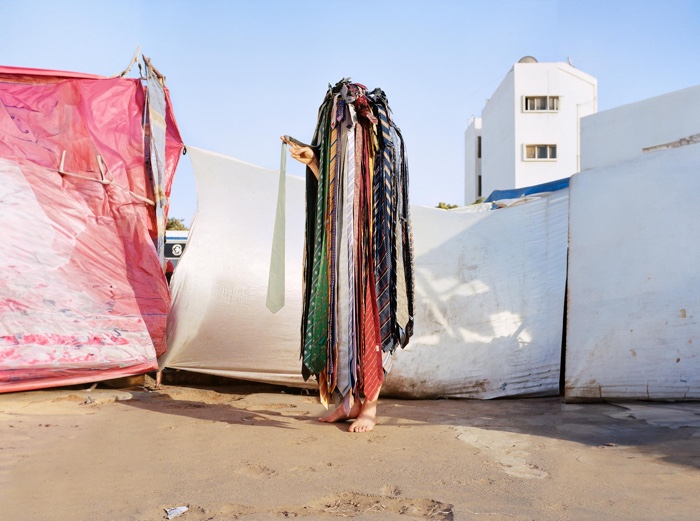
Jeremy Hutchison, Dead White Man, 2022-2023. Photo by Dani Pujalte
In his Dead White Man body of work, Jeremy Hutchison uses his position as a white, male, Western consumer to embody the toxic nature of Northern charity. Wearing striking costumes made from secondhand clothes sourced in Dakar, his caucasian body becomes a spectre of waste colonialism. The photos, which hijack the forms and codes of fashion campaigns, are as obscene and bloated as the fast fashion industry itself.
Through this act of détournement, the project contests the myths that sanitise the secondhand clothing trade – with its reassuring claims to charity, sustainability and reuse. In their place, it sets out to reveal the racist ideology that treats the Global South as a waste management solution.
The project not only reveals the way we outsource the most unpalatable aspects of overconsumption but it also deals with white men’s guilt without hypocritical self-flagellation or visual exploitation of local suffering.
I asked Jeremy Hutchison to tell us about the background of the project:
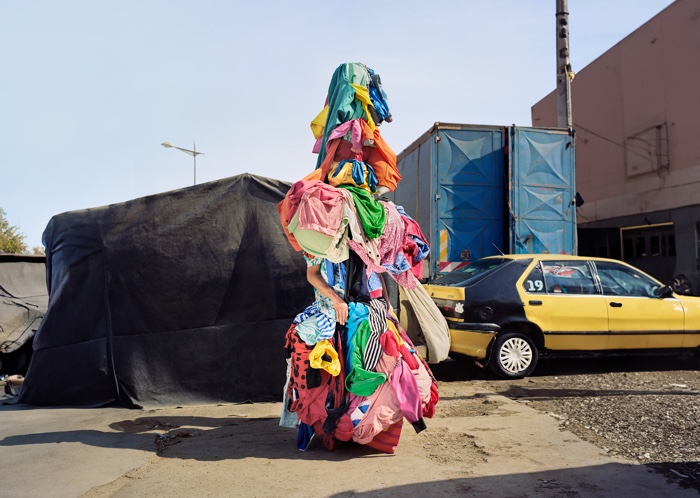
Jeremy Hutchison, Dead White Man, 2022-2023. Photo by Dani Pujalte
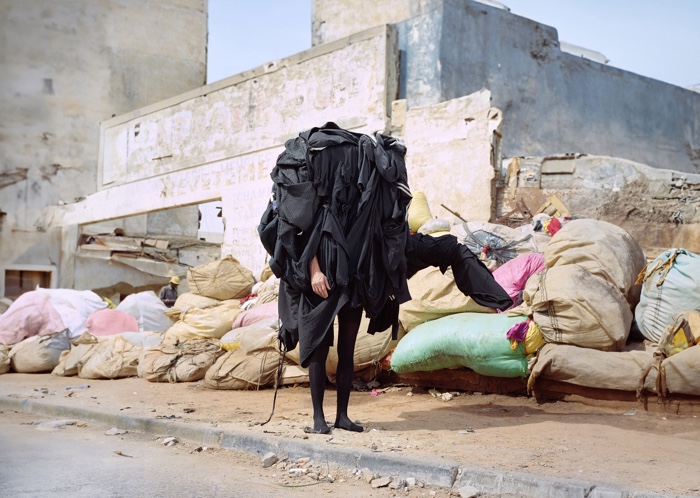
Jeremy Hutchison, Dead White Man, 2022-2023. Photo by Dani Pujalte
Hi Jeremy! How did you get engaged with the problem of our textile trash and the way we outsource their dismantling (and all the ecological and social issues associated with it) to Africa?
It started back in 2017 when I was on a residency in Dakar (Senegal). Cycling around the city, I saw clothes everywhere: Cars covered in jeans. Sneakers dangling from trees. Shirts hanging from traffic lights. The city was a market, dressed in secondhand clothes. Every so often a truck would pull up, and a team of men would gather to ferry hundreds of clothing bales into a shop. Confused, I asked a shopkeeper: Where are all these clothes from? ‘From your country,’ he said. ‘From the North.’
Until then, I was perfectly ignorant about the global trade in secondhand clothes. I knew nothing of the dumping of textile waste across the Global South, and the consequent obliteration of Africa’s textile industries. Given that my art practice is largely focused on global flows of consumer goods, this came as a bit of a surprise. But it shouldn’t have: the secondhand clothing industry is supposed to be obscure.
Most UK consumers are shocked to learn that their charitable donations are sold in Africa, rather than freely distributed. I suppose it distorts the image of charity. But global charities follow neoliberal models: they obscure the true patterns of capitalist exchange. The point is, our ignorance of this trade is vital: it benefits the charities, and it benefits fast fashion brands. The more often we empty our wardrobes, the more often we return to H&M. It’s a win-win.
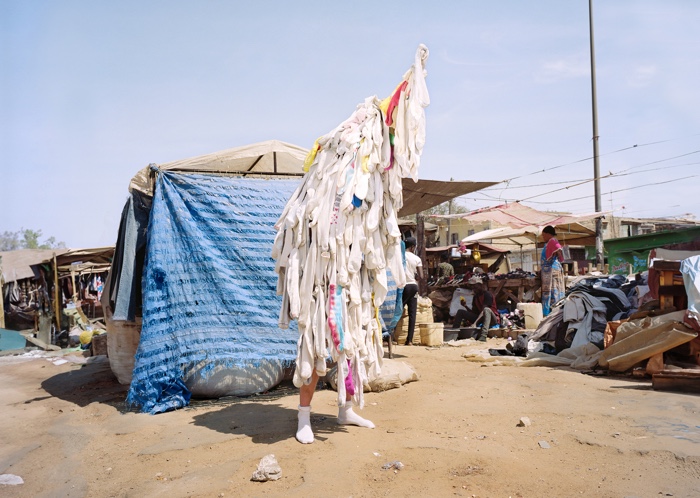
Jeremy Hutchison, Dead White Man, 2022-2023. Photo by Dani Pujalte
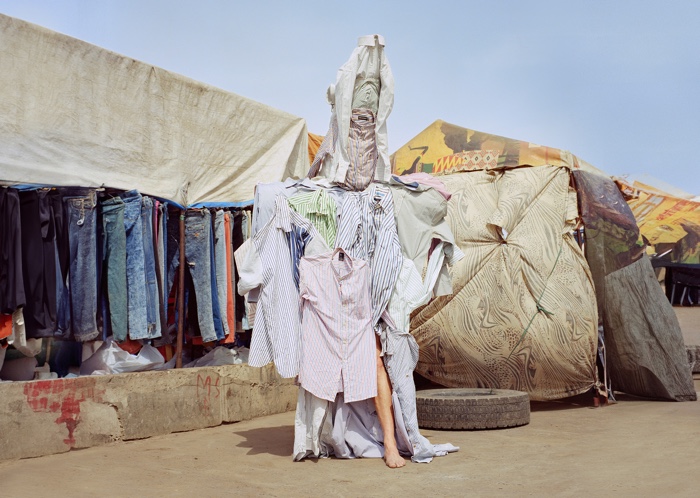
Jeremy Hutchison, Dead White Man, 2022-2023. Photo by Dani Pujalte
What guided the aesthetic/visual composition of the fabric that you piled onto your body?
In Ghana, they refer to our secondhand clothes as ‘obroni wawu’ – Dead White Men’s Clothes. So in this work I manifest that image: I perform the dead white man. Constructing a series of wearable sculptures from secondhand clothes, I become the embodiment of this toxic industry. Sometimes this monster is a tower of multicoloured garments. Sometimes he’s made of pinstripe shirts, or ties, or chinos, or socks. With each incarnation, my caucasian flesh is displayed: a white hand, leg, arm, or foot. In literal terms, I perform my own whiteness.
The aesthetic of the work is very specific: I wanted to reproduce the visual language of neoliberalism – the seductive appeal of design, fashion and high-street branding. Because if it’s going to have any effect, this work needs to circulate through the mass media: to parasite its way into the visual frenzy of the fashion world. To achieve this visual surface, I worked very closely with the Barcelona-based fashion photographer Dani Pujalte – (currently shooting the Christmas campaign for Zalando) – as well as the stylists Devin Hentz and Aga Wood. We looked at ways for the monster to seduce and disgust. To appeal and repel. To be the object of his own critique.
Monstrous costumes are common in African performance cultures – but they exist throughout global folk traditions. Both person and thing, these costumed monsters play an important social function – and this is what interests me. They manifest the object of fear. And in the process, they produce the possibility of exorcism.

Jeremy Hutchison, Dead White Man, 2023. Photo by Dani Pujalte
Are the DWM performative sculptures just about the visual effect of a body buried under these fabrics? Or is there a more physical element to the work? I imagine it must have been a painful experience to pose and move with heavy, maybe smelly fabrics, some of them perhaps toxic under the sun….
Yes, this work is physical. The clothes are hot. Their collars are stained. Their pockets are filled with trash. So if the performance was unpleasant, smelly and disgusting for me, this was important. Because the work is about manifesting the Dead White Man – a revolting, imperialistic monster.
But that’s just the start of the physical process. Because what do monsters want? They want to go home. (viz. Frankenstein’s monster) This monster wants to go back to the Global North. So in the video, we see him wandering the streets of Dakar, seeking his way to the shipping port. He finally comes upon a container that will return him to Europe. Once on the other side, he reinserts himself into the material structures of modern Britain: the shopping malls, the high streets, the fashion magazines, the banks. The monster returns home.

Jeremy Hutchison, Dead White Man, 2022-2023. Photo by Dani Pujalte
Can you develop the concept of “zombie imperialism” which is at play in the global trade of post-consumer garments??
A zombie is basically a corpse that refuses to die. So I came up with the term “zombie imperialism” to describe a kind of colonial mentality that refuses to die. In this case, through the secondhand clothing trade. Because disguised beneath its reassuring claims to charity and sustainability, this industry operates on a foundation of white supremacy.
To explain what I mean, let’s explore how a well-meaning British consumer participates in the secondhand clothing industry: I get a little polythene bag delivered through my front door. This might have a charity logo on it, but essentially it’s a bin bag. And I put my clothes in this bin bag. And where do I leave it? Out by the bins! Or I might go down to the supermarket. And there in the carpark I find this line of massive steel bins. And I pop my clothes in the bin, and I forget about them.
These garments occupy the same industrialised processes as garbage. Meaning, this stuff is garbage. Yet the global fashion industry has rebranded my trash as a resource – an opportunity for people in the global south – meaning that I can go back to the high street and buy a whole load more clothes. According to their logic, my trash is Africa’s goldmine. According to the Or Foundation research, 40 per cent of the clothes that arrive in Kantamanto market go directly to landfill. My trash is their trash.
This assumption that my garbage can be rebranded as charity is white supremacy, pure and simple. It’s an ideology that treats the Global South as a waste management solution. And it has a name: waste colonisation.
Where did you source the fabrics you used for the Dead White Man performance?
These clothes come from Colobane – Senegal’s largest market for secondhand goods. This market is so vast it’s literally divided into different countries: Gambia, Congo, Burkina Faso, Italy, France, the United States, the UK… There’s a famous saying in Wolof: Lepp looy wut rekk am na marsé Colobane / “You can find anything in the world at Colobane”. It’s a dizzying place: the repository of millions of used objects from the Global North. In some ways, Colobane feels less like a fixed place – more like a convergence of globalised spaces.
Anyway, I bought these clothes directly from Colobane’s market stalls. Each stall specialises in a specific garment: shirts / jeans / chinos / ties / socks etc. Sometimes, the product display can be very innovative. But often the sheer quantity of garments results in a vast heap of clothes, sprawled across tarpaulin. If you squint, they look like bodies, collapsed under their own weight. At least, they did to me.

Dead White Man textile workshop with Jeremy Hutchison at the Festival of Making, Blackburn. Photo credit Jack Bolton
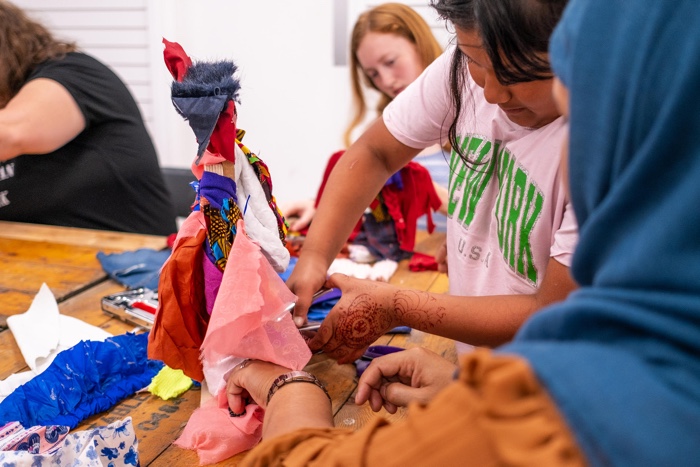
Dead White Man textile workshop with Jeremy Hutchison at the Festival of Making, Blackburn. Photo credit Jack Bolton

Dead White Man textile workshop with Jeremy Hutchison at the Festival of Making, Blackburn. Zombie by Summer Anwar
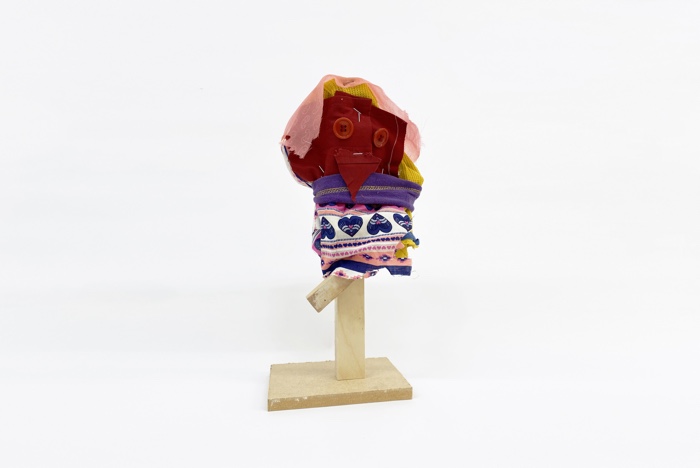
Dead White Man textile workshop with Jeremy Hutchison at the Festival of Making, Blackburn. Zombie by Bethany Pye
The work takes different forms: performative sculptures, video, text, billboards and public workshops. Can you tell me about the billboards and workshops?
I’ll start with the billboards, since the circulation of this work is key. Dead White Man needs to live alongside BooHoo, Pretty Little Thing, Nasty Gal, etc – almost like the bastard child of the fast fashion family. So at the British Textile Biennial, he’ll appear on LED screens, digital billboards and bus stops – right alongside those brands – wafting his toxic stench into the polished spaces of the mass media. This is where the work will do its work.
About the workshops: Over the past few months, we’ve worked in schools, community centres and shopping malls. Several hundred people have taken part – making figurines of the Dead White Man. Bales of secondhand clothes have been shredded into scraps, allowing people to transform wooden armatures into miniature monsters. The results will be exhibited at the biennial.
What interests me about these objects is how they operate inside a tradition of ritualistic dolls. Shamanic practices have used them for millennia as vehicles for purification and healing; as surrogates for a person. So in a sense, I’m interested in how these figurines function as surrogates for the workshop participant. For the consumer. After all, we all participate in the global fashion industry. And if you want to understand a monster, I think it’s helpful to manifest it.
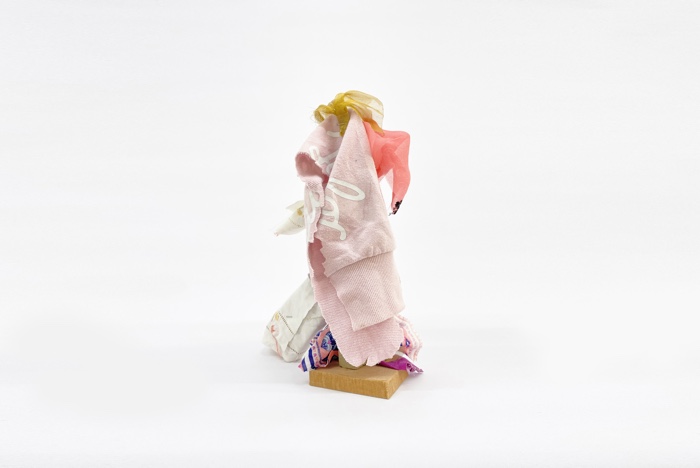
Dead White Man textile workshop with Jeremy Hutchison at the Festival of Making, Blackburn. Zombie by Aaminah Gamgori

Dead White Man textile workshop with Jeremy Hutchison at the Festival of Making, Blackburn. Zombie by Tasheem Khalid
Can you tell us about the research process? You developed the work over the course of two residencies at Raw Material Company in Dakar. It then evolved with the help of The Or Foundation, an activist group that works in Kantamanto, Accra – the largest secondhand market in West Africa. Are the realities you encountered in Senegal very different from the ones in Ghana?
I’m definitely no expert about this industry and its local variations across Africa. But it’s true that there are nuances in different countries. I’ll give you an example of a phenomenon specific to Ghana:
In Kantamanto market, The Or Foundation are working with ‘kayayei’. Translating as “she who carries the burden”, this is the name given to women who are paid to carry 55kg clothing bales on their heads. In some cases, this is more than their body weight. Skeletal damage is to be expected. Sometimes their necks snap under the weight. And worse, since many are mothers without access to childcare, they are forced to carry their babies on their backs. Weaving through the crowded market, there are accounts of clothing bales falling onto babies, crushing them to death.
My research has involved a lot of listening. Sitting with a lot of difficult information. Experiencing the slow undoing of my inherited assumptions. And most of all, understanding my own whiteness. Throughout my art practice, I’ve used my own subject position (white, male, British, consumer) as a vehicle to explore asymmetries of power under global capitalism. This work has taken that idea to a new level: I’ve literally become a monster.
In the process, I’ve been fortunate enough to be educated by a number of people who I’d like to namecheck here: Cheikha Sigil (artist/designer, Dakar), Maya Varichon El Zanaty (curator, Dakar) Marie Helene Pereira (Raw Material Company, Dakar), Liz Ricketts (The Or Foundation, Accra).
The description of your project states that “Around 24 billion items of clothing are donated to charity every year.” That is worldwide, right? Do you have any idea about what happens to all the discarded clothing that has not been donated to charities? Do they just get burnt?
Yes, that figure is worldwide. According to the UN, it equates to around three garments for every person on the planet.
Generally speaking, secondhand clothes are sorted into three categories: reuse, rags and fibre. Those that aren’t processed for reuse are shredded, melted, pelletised and compressed. The flocking industry deals with much of this, turning them into furniture padding, panel linings, loudspeaker cones, car insulation, etc.
Thanks Jeremy!
Dead White Man is part of the British Textile Biennial which opens in various venues across Lancashire and runs from 29 September until 29 October 2023.
Previously: Crises of labour, language and behaviour. An interview with Jeremy Hutchison, Err (or the creativity of the factory worker), a conversation with Jeremy Hutchison, Transnationalisms – Bodies, Borders, and Technology. Part 1. The exhibition.
WPP’s media buying arm GroupM today announced a global partnership with Swedish adaptive streaming company SeenThis, a move that the companies say will let advertisers reduce the carbon emissions of video ads. The SeenThis tech avoids data-intensive uploading and downloading techniques used by traditional video ads, instead streaming directly to the end viewer through display…
Tinuiti finds TikTok Gen Z’s biggest source of new CPG product discovery on social, as Walmart and targeted ads also do well.
Donald J. Trump is the most important figure in the Republican Party, but he merited only 10 minutes of questions from the moderators, Bret Baier and Martha MacCallum.